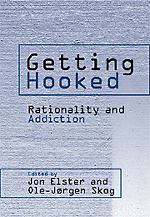Book contents
- Frontmatter
- Contents
- Preface and Acknowledgments
- Contributors
- Introduction
- Addiction and Social Interaction
- Addiction, Weakness of the Will, and Relapse
- The Dangers of Willpower
- The Neurobiology of Chemical Addiction
- To Legalize or Not to Legalize: Is That the Question?
- Rationality, Irrationality, and Addiction – Notes on Becker's and Murphy's Theory of Addiction
- Gambling and Addiction
- A Visceral Account of Addiction
- Epilogue: Rationally Coping with Lapses from Rationality
- Index
The Neurobiology of Chemical Addiction
Published online by Cambridge University Press: 05 June 2012
- Frontmatter
- Contents
- Preface and Acknowledgments
- Contributors
- Introduction
- Addiction and Social Interaction
- Addiction, Weakness of the Will, and Relapse
- The Dangers of Willpower
- The Neurobiology of Chemical Addiction
- To Legalize or Not to Legalize: Is That the Question?
- Rationality, Irrationality, and Addiction – Notes on Becker's and Murphy's Theory of Addiction
- Gambling and Addiction
- A Visceral Account of Addiction
- Epilogue: Rationally Coping with Lapses from Rationality
- Index
Summary
Jeanette, a single unmarried mother of two, lives in subsidized housing in an economically depressed inner-city region of a major American city. She works as a countergirl in a fast-food hamburger restaurant, earning close to the minimum legal wage. She ekes out an existence on her wages, government-supplied food stamps, subsidies for her two children, and assistance with both food and child care from her mother, who lives nearby and works as a domestic housecleaner. One Friday evening, after getting her week's wages, she receives a telephone call from one of her occasional boyfriends, who informs her that he has just acquired some “crack” (freebase) cocaine and some beer and is planning a party for that night with some friends. Jeanette is invited to “come on over, do a few rocks with us, and have some fun.” After some moments of indecision, Jeanette accepts the invitation. She is told to “bring some money, to pay for the crack you use.” Jeanette then carefully counts her week's wages, estimates the amount she will need over the coming week for food, rent, and other necessities, and then “precommits” herself to use for the crack party only those dollars she will not need for “necessary money” over the coming week. She gives her children to a girlfriend in the same building to watch for the night and also gives the girlfriend all her “necessary money” for the coming week, telling the girlfriend to “not give it back to me before Monday, no matter how hard I beg.”
- Type
- Chapter
- Information
- Getting HookedRationality and Addiction, pp. 93 - 136Publisher: Cambridge University PressPrint publication year: 1999
- 9
- Cited by



